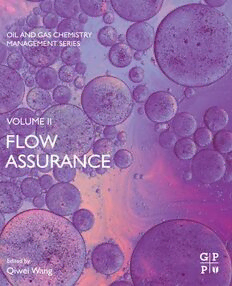
Flow Assurance (Volume 2) (Oil and Gas Chemistry Management Series, Volume 2) PDF
Preview Flow Assurance (Volume 2) (Oil and Gas Chemistry Management Series, Volume 2)
Flow Assurance Oil and Gas Chemistry Management Series Flow Assurance Volume II Edited by Qiwei Wang Saudi Aramco, Dhahran, Saudi Arabia GulfProfessionalPublishingisanimprintofElsevier 50HampshireStreet,5thFloor,Cambridge,MA02139,UnitedStates TheBoulevard,LangfordLane,Kidlington,Oxford,OX51GB,UnitedKingdom Copyright©2022ElsevierInc.Allrightsreserved. Nopartofthispublicationmaybereproducedortransmittedinanyformorbyanymeans,electronic ormechanical,includingphotocopying,recording,oranyinformationstorageandretrievalsystem, withoutpermissioninwritingfromthepublisher.Detailsonhowtoseekpermission,further informationaboutthePublisher’spermissionspoliciesandourarrangementswithorganizationssuch astheCopyrightClearanceCenterandtheCopyrightLicensingAgency,canbefoundatourwebsite: www.elsevier.com/permissions. Thisbookandtheindividualcontributionscontainedinitareprotectedundercopyrightbythe Publisher(otherthanasmaybenotedherein). Notices Knowledgeandbestpracticeinthisfieldareconstantlychanging.Asnewresearchandexperience broadenourunderstanding,changesinresearchmethods,professionalpractices,ormedical treatmentmaybecomenecessary. Practitionersandresearchersmustalwaysrelyontheirownexperienceandknowledgeinevaluating andusinganyinformation,methods,compounds,orexperimentsdescribedherein.Inusingsuch informationormethodstheyshouldbemindfuloftheirownsafetyandthesafetyofothers,including partiesforwhomtheyhaveaprofessionalresponsibility. Tothefullestextentofthelaw,neitherthePublishernortheauthors,contributors,oreditors,assume anyliabilityforanyinjuryand/ordamagetopersonsorpropertyasamatterofproductsliability, negligenceorotherwise,orfromanyuseoroperationofanymethods,products,instructions,orideas containedinthematerialherein. ISBN:978-0-12-822010-8 ForInformationonallGulfProfessionalPublishingpublications visitourwebsiteathttps://www.elsevier.com/books-and-journals Publisher:CharlotteCockle SeniorAcquisitionsEditor:KatieHammon SeniorEditorialProjectManager:SaraValentino ProductionProjectManager:SojanP.Pazhayattil CoverDesigner:MilesHitchen TypesetbyMPSLimited,Chennai,India Contents List ofcontributors..................................................................................................xv CHAPTER 1 Gas hydrate management.............................................1 Gaurav Bhatnagarand Shawn Gao 1.1 Introduction....................................................................................2 1.2 Fundamentals ofhydrate................................................................3 1.2.1 Definition............................................................................3 1.2.2 Structures.............................................................................3 1.2.3 Phase behavior....................................................................6 1.2.4 Properties.............................................................................8 1.3 Hydrateformation........................................................................10 1.3.1 Hydrate formationscenarios.............................................10 1.3.2 Hydrate formationmechanism.........................................10 1.4 Hydratemanagement inproduction systems...............................11 1.4.1 Risk assessment.................................................................12 1.4.2 Hydrate modeling..............................................................12 1.5 Temperature control.....................................................................27 1.5.1 Thermal insulation............................................................27 1.5.2 Active heating...................................................................32 1.6 Chemicalinhibition......................................................................36 1.6.1 Thermodynamichydrate inhibitors...................................36 1.6.2 Low-dosagehydrate inhibitors.........................................40 1.7 Dehydration..................................................................................64 1.8 Hydrateremediation.....................................................................66 1.8.1 Depressurization................................................................66 1.8.2 Heating..............................................................................67 1.8.3 Chemical dissociation.......................................................68 1.8.4 Model predictionsfor remediation...................................69 1.9 Case studies..................................................................................69 1.9.1 Hydrate management indrytree facilityfacilities..........69 1.9.2 Low-dosagehydrate inhibitor field application...............72 1.9.3 Tommeliten-gamma field.................................................73 1.9.4 RemediationofhydratepluginwestAfricadeepwater floatingproductionstorageandoffloading............................75 1.10 Summary.......................................................................................77 Nomenclature...............................................................................77 References....................................................................................78 v vi Contents CHAPTER 2 Paraffin management..................................................85 MikeNewberry and David W.Jennings 2.1 Historyof paraffin management developments..........................85 2.2 Crude oil andparaffinchemistry.................................................88 2.3 Paraffinanalysis andcrude oilcharacterization..........................91 2.3.1 Paraffin analysismethods.................................................91 2.3.2 Crude oil characterization.................................................93 2.4 Paraffindeposition.....................................................................103 2.4.1 Paraffin depositionmechanisms.....................................103 2.4.2 Paraffin depositionmodeling..........................................106 2.4.3 Paraffin deposit characteristics.......................................111 2.4.4 Paraffin depositioncontrol..............................................114 2.5 Pour point/crude oil gelling problems.......................................153 2.5.1 Crude oil gellingmechanism..........................................153 2.5.2 Gelled flowlinecharacteristics.......................................155 2.5.3 Pourpoint treatment........................................................156 2.6 Case histories..............................................................................165 2.6.1 Formationdamage..........................................................165 2.6.2 Well tubing deposition....................................................168 2.6.3 Flowline deposition.........................................................170 2.6.4 Tank bottoms...................................................................175 2.7 Summary.....................................................................................175 Nomenclature.............................................................................176 References..................................................................................177 CHAPTER 3 Asphaltene management...........................................185 Priyanka Juyal and Andrew TYen 3.1 Introduction................................................................................186 3.2 Chemistryof asphaltenes...........................................................186 3.2.1 Composition and structure..............................................186 3.2.2 Solubilityand aggregation..............................................188 3.3 Experimentaltechniquesforasphaltenestabilityprediction.........191 3.3.1 Solids detection system...................................................191 3.3.2 DeBoer plot.....................................................................192 3.3.3 Dead oil tests...................................................................192 3.4 Asphaltene stability modeling....................................................194 3.4.1 Asphaltene instabilitytrend modeling............................194 3.4.2 Asphaltene deposition model..........................................195 3.5 Asphaltene inhibitor lab tests.....................................................198 3.5.1 Precipitation tests............................................................199 Contents vii 3.5.2 Deposition tests...............................................................201 3.5.3 Live oil tests....................................................................207 3.6 Asphaltene control inoil production.........................................211 3.6.1 Prevention........................................................................211 3.6.2 Remediation....................................................................213 3.7 Case studies................................................................................213 3.7.1 Labscreening methods for fieldapplications................213 3.7.2 Evaluating asphaltene inhibitorsfor anoffshore alaskan producer.............................................................214 3.7.3 Developmentofmultifunctional stabilizers of asphaltenes......................................................................215 3.8 Conclusion and path forward.....................................................215 Acknowledgment.......................................................................217 Nomenclature.............................................................................217 References..................................................................................218 CHAPTER 4 Naphthenate and carboxylate soap treatment.........227 Jonathan J. Wylde 4.1 Introduction................................................................................228 4.1.1 Overview and chapter orientation..................................228 4.1.2 Naphthenatesand recent history.....................................228 4.1.3 Definitions: acid crude oil and“naphthenates”..............231 4.1.4 Originofacidic crude.....................................................234 4.1.5 Carboxylate and naphthenate soap operational challenges........................................................................235 4.1.6 Thecontinuum model.....................................................237 4.2 Fouling mechanisms ofnaphthenate andcarboxylate soaps...........................................................................................238 4.2.1 Analytical techniques for acidic species in crude oils.........................................................................238 4.2.2 Soapemulsions...............................................................244 4.2.3 Naphthenatesoap solids..................................................252 4.2.4 Highcalcium incrude caused by oil-dispersible naphthenates....................................................................259 4.2.5 Refinery challenges overview.........................................262 4.3 Chemicalcontrol methodologies and laboratory testing...........263 4.3.1 Introduction.....................................................................263 4.3.2 Preventive chemical strategies........................................264 4.3.3 Remediationand remedial chemical strategies..............270 4.3.4 Laboratory and field testing............................................271 4.4 Concluding remarksand remaining challenges.........................272 viii Contents Nomenclature.............................................................................273 Acknowledgments.....................................................................274 References..................................................................................274 CHAPTER 5 Inorganic mineral scale mitigation..........................287 Gordon Michael Grahamand DarioMarcello Frigo 5.1 Introduction................................................................................288 5.1.1 The roleof water.............................................................289 5.1.2 Inorganicmineral scalingin the oil environment..........291 5.2 Basic principles ofinorganic scale formation...........................293 5.2.1 Types of inorganicmineral scale...................................293 5.2.2 Inorganicmineral scale formation..................................298 5.2.3 Scale nucleation andgrowth...........................................305 5.2.4 Thermodynamics andkinetics........................................309 5.3 Scaleprediction..........................................................................311 5.3.1 Scale prediction asa component of scale management....................................................................311 5.3.2 Scale prediction outputs..................................................312 5.3.3 Theory of scale prediction..............................................315 5.3.4 Importance ofqualityinput data....................................319 5.3.5 Example ofthe utilityofmodern scale prediction packages.........................................................321 5.3.6 Limitations ofscale prediction.......................................322 5.4 Scalecontrol...............................................................................323 5.4.1 Treatment options and scale control strategies..............323 5.4.2 Chemicalinhibition.........................................................330 5.4.3 Types of scale inhibitors commonlyused inoil industry............................................................................334 5.4.4 Brief history ofscaleinhibitor development..................341 5.4.5 Chemicaldeployment.....................................................342 5.4.6 Chemicalinhibition.........................................................344 5.4.7 Factors controlling the performance of genericallydifferent inhibitor chemistries.....................348 5.4.8 Laboratoryassessment of scale inhibitors......................359 5.4.9 Chemicalqualification: final considerations..................371 5.5 Scaleinhibitor squeeze...............................................................372 5.5.1 Chemicalsqueezeprocess..............................................372 5.5.2 Chemicalretentionmechanisms.....................................381 5.5.3 Chemicaltesting of scale inhibitor squeeze treatments:reservoircondition core flooding................387 Contents ix 5.5.4 Theimportance ofappropriate core floodtesting protocols..........................................................................388 5.5.5 SI Application considerations: formationdamage and inhibitor retention/release properties.......................392 5.5.6 Importance of accurate assay and monitoring................403 5.5.7 Isothermderivation and near-wellbore simulation.........406 5.6 Scale remediation.......................................................................412 5.6.1 Acid soluble vsacidinsoluble scales.............................413 5.6.2 Mechanical Remediation/Physical Methods...................414 5.6.3 Chemical dissolution.......................................................416 5.6.4 Chemical deployment inscale dissolution.....................417 5.6.5 Acids for ScaleDissolution............................................419 5.6.6 Chelating agents for scale dissolution............................422 5.7 Summary.....................................................................................426 Nomenclature.............................................................................426 References..................................................................................428 CHAPTER 6 Sand control completion using in-situ resin consolidation.............................................................443 PhilipNguyen and Mike Sanders 6.1 Sand control................................................................................443 6.1.1 Mechanisms andcausesof sand production..................443 6.1.2 Problems/issuesof sand production...............................444 6.1.3 Sandcontrol methods......................................................444 6.1.4 Other wellbore stabilizationmethods for sand control.....................................................................447 6.1.5 Perforating techniques for completionsusing sand-consolidation treatments.........................................448 6.1.6 Chemical sand consolidation..........................................451 6.2 Fines Migration control..............................................................472 6.2.1 Mechanisms andcauses..................................................472 6.2.2 Previousfinesmigration control methods......................474 6.2.3 Controlling finesmigration intoproppant pack.............475 6.2.4 Fines migration field case histories................................478 6.3 Proppantflowbackcontrol.........................................................479 6.3.1 Primary proppant flowback control................................479 6.3.2 Remedial methods for proppant flowback.....................490 6.3.3 Lessons learned/recommendations.................................493 Nomenclature.............................................................................494 References..................................................................................494 x Contents CHAPTER 7 Condensate and water blocking removal................503 Mashhad Fahes 7.1 Introduction................................................................................503 7.2 Background theory.....................................................................505 7.2.1 Fluid phase behavior.......................................................505 7.2.2 Pressure profiles..............................................................506 7.2.3 Two-phase flow challenges............................................509 7.3 Field examplesand industrypractice........................................514 7.3.1 Ichthys gas-condensate field inAustralia.......................514 7.3.2 Cupiaguagas-condensatefield inColumbia..................515 7.3.3 Other examples...............................................................516 7.4 Recent advances inresearchand development.........................520 7.4.1 Wettabilityalteration......................................................520 7.4.2 CO huff-n-puff...............................................................528 2 7.4.3 Other new technologies..................................................530 7.5 Final remarks..............................................................................530 Nomenclature.............................................................................531 References..................................................................................532 CHAPTER 8 Foam-assisted liquid lift...........................................541 FenfenHuang and KeesC.A.M. Veeken 8.1 Introduction................................................................................542 8.2 Liquidloadingand deliquification.............................................544 8.2.1 Liquid loading.................................................................544 8.2.2 Continuous deliquification..............................................549 8.2.3 Intermittent deliquification.............................................551 8.3 Foam-assisted lift.......................................................................552 8.3.1 Foam-assisted lift performance.......................................552 8.3.2 Foam-assisted lift operatingenvelope............................555 8.3.3 Foam-assisted gas lift......................................................556 8.3.4 Surface foam-assisted lift................................................556 8.4 Foam-assisted lift application....................................................556 8.5 Well performance.......................................................................557 8.5.1 Collect well data.............................................................557 8.5.2 Diagnoseand forecastliquid loading.............................557 8.5.3 Predict foam-assisted lift operatingparameters.............559 8.6 Laboratory testing......................................................................562 8.6.1 Foamer performance.......................................................564 8.6.2 Secondaryperformance..................................................566 8.7 Foam-assisted lift field testing...................................................568
